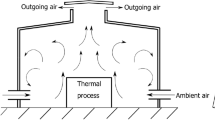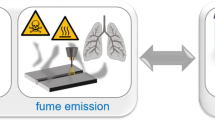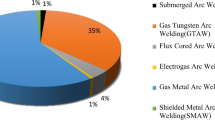Abstract
Background
Studies concerning welding fume–related adverse health effects in welders are hampered by the heterogeneity of workplace situations, resulting in complex and non-standardized exposure conditions.
Methods
In order to carry out welding fume exposure studies under controlled and standardized conditions, the Aachen Workplace Simulation Laboratory was developed. This laboratory consists of an emission room, in which welding fume is produced, and an exposure room in which human subjects are exposed to these fumes. Both rooms are connected by a ventilation system which allows the welding fume concentration to be regulated. Particle mass concentration was measured with a TEOM microbalance and the particle number-size distribution using a Grimm SMPS device.
Results
In a study, which is the subject of this paper, it has been shown that welding fume concentration can easily be regulated between 1 and about 3 mg m−3. The chosen concentration can be kept constant for more than 8 h. However, transport of the particles from the emission room into the exposure room leads to a change in particle size distribution, which is probably due to coagulation of the fraction of smallest particles.
Conclusion
The Aachen Workplace Simulation Laboratory is suitable for controlled exposure studies with human subjects.







Similar content being viewed by others
References
Antonini JM, Lewis AB, Roberts JR, Whaley DA (2003) Pulmonary effects of welding fumes: review of worker and experimental animal studies. Am J Ind Med 43:350–360
Christensen SW, Bonde JP, Omland O (2008) A prospective study of decline in lung function in relation to welding emissions. J Occup Med Toxicol 3:6
de Haar C, Hassing I, Bol M, Bleumink R, Pieters R (2006) Ultrafine but not fine particulate matter causes airway inflammation and allergic airway sensitization to co-administered antigen in mice. Clin Exp Allergy 36:1469–1479
Dvonch JT, Marsik FJ, Keeler GJ, Robins TG, Yip F, Morishita M (2000) Field comparison of PM2.5 teom and PM2.5 manual filter-based measurement methods in urban atmospheres. J Aerosol Sci 31:190–191
Erkinjuntti-Pekkanen R, Slater T, Cheng S, Fishwick D, Bradshaw L, Kimbell-Dunn M, Dronfield L, Pearce N (1999) Two year follow up of pulmonary function values among welders in New Zealand. Occup Environ Med 56:328–333
Hauck H, Berner A, Gomiscek B, Stopper S, Puxbaum H, Kundi M, Preining O (2004) On the equivalence of gravimetric PM data with TEOM and beta-attenuation measurements. J Aerosol Sci 35:1135–1149
Jenkins NT, Pierce WMG, Eagar TW (2005) Particle size distribution of gas metal and flux cored arc welding fumes. Weld J 84:156s–163s
Jeonga C-H, Evansa GJ (2009) Inter-comparison of a fast mobility particle sizer and a scanning mobility particle sizer incorporating an ultrafine water-based condensation particle counter. Aerosol Sci Technol 43:364–373
Jerez SB, Zhang Y, McClure JW, Jacobson L, Heber A, Hoff S, Koziel J, Beasley D (2006) Comparison of measured total suspended particulate matter concentrations using tapered element oscillating microbalance and a total suspended particulate sampler. J Air Waste Manag Assoc 56:261–270
Monteiller C, Tran L, MacNee W, Faux S, Jones A, Miller B, Donaldson K (2007) The pro-inflammatory effects of low-toxicity low-solubility particles, nanoparticles and fine particles, on epithelial cells in vitro: the role of surface area. Occup Environ Med 64:609–615
Schwab JJ, Spicer J, Demerjian KL, Ambs JL, Felton HD (2004) Long-term field characterization of tapered element oscillating microbalance and modified tapered element oscillating microbalance samplers in urban and rural New York State locations. J Air Waste Manag Assoc 54:1264–1280
Stephenson D, Seshadri G, Veranth J (2003) Workplace exposure to submicron particle mass and number concentrations from manual arc welding of carbon steel. AIHA J 64:516–521
Stolzel M, Breitner S, Cyrys J, Pitz M, Wolke G, Kreyling W, Heinrich J, Wichmann HE, Peters A (2007) Daily mortality and particulate matter in different size classes in Erfurt, Germany. J Expo Sci Environ Epidemiol 17:458–467
Tuch T, Mirme A, Tamm E, Heinrich J, Heyder J, Brand P, Roth C, Wichmann HE, Pekkanen J, Kreyling WG (2000) Comparison of two particle-size spectrometers for ambient aerosol measurements. Atmos Environ 34:139–149
Acknowledgments
We thank Kathy Bischof for her editorial assistance. The study was supported by DFG and RWTH Aachen University.
Conflict of interest
The authors declare that they have no conflict of interest.
Author information
Authors and Affiliations
Corresponding author
Rights and permissions
About this article
Cite this article
Brand, P., Havlicek, P., Steiners, M. et al. Exposure of healthy subjects with emissions from a gas metal arc welding process: part 1—exposure technique and external exposure. Int Arch Occup Environ Health 86, 25–30 (2013). https://doi.org/10.1007/s00420-012-0739-7
Received:
Accepted:
Published:
Issue Date:
DOI: https://doi.org/10.1007/s00420-012-0739-7




